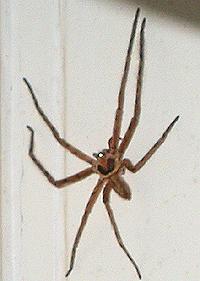Two of these girls in the panel at todays inspection.
Okay, what kind of spider is it?
Black Widow!!!
OUCH!
Black widows are notorious spiders identified by the colored, hourglass-shaped mark on their abdomens. Several species answer to the name, and they are found in temperate regions around the world.
This spider’s bite is much feared because its venom is reported to be 15 times stronger than a rattlesnake’s. In humans, bites produce muscle aches, nausea, and a paralysis of the diaphragm that can make breathing difficult; however, contrary to popular belief, most people who are bitten suffer no serious damage—let alone death. But bites can be fatal—usually to small children, the elderly, or the infirm. Fortunately, fatalities are fairly rare; the spiders are nonaggressive and bite only in self-defense, such as when someone accidentally sits on them.
The animals most at risk from the black widow’s bite are insects—and male black widow spiders. Females sometimes kill and eat their counterparts after mating in a macabre behavior that gave the insect its name. Black widows are solitary year-round except during this violent mating ritual.
Cool… never actually seen one of those. Is it normal, as well, to see plants growing in your panels??
Really? Those things are almost as common as house-flys out here. I thought everyone had to deal with them. Go figure. . .
Same here, those and brown recluse. Ive squashed a slew of them.
Same here. Once I had one walk across my hand.
Mike, the article didn’t mention another interesting fact, the egg sacs yield between 300 and 500 baby spiders each. When they are first born, they are all stretched out perfectly symetrically on a web, you just about need a magnifying glass to see them. They are a translucent white. Their only source of food at that point is each other. They eat each other until only the last of the strongest survive, about 2 or 3.
They are also fairly resistant to insect sprays, and residual sprays do not kill them. A blowtorch works quite well however.
That one is a beauty, nice picture…
http://greennature.com/gallery/spider-pictures/giant-house-spider.jpg
Hobo Spider in the North West
This thread came to mind yesterday. I went to an open house in a new subdivision and in the utility room of a new house found one of those (black widow) already moved in !!
Mike,
When I lived in Hawaii, we didn’t have too much trouble with spiders but good grief the scorpions and man eating centipedes were always getting into the house.
Oh Yeah. that’s him and sorry for calling you Mike instead of Mark.
No worries, I’ve been called alot worse. If you look closely its a female wrapped around 100’s of baby centipedes.
Bruce, is that thing as big as it looks in the picture?
Yes, these girls are big. The males are less than 1/10 that size.




